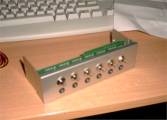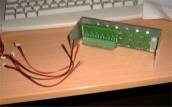Introduction
Noise. This is something almost all computer users are familiar with. With today’s monster CPUs come fans. Add a speedy graphics card and you get more fans. Then add even more case fans – ‘just in case you want to o/c’. Every fan adds to the noise. When playing a game the noise probably isn’t a problem but start surfing the web or using the computer for other stuff (web work etc.) and you’ll soon notice that irritating background noise.
There are, of course, ways to lower the noise. You can use more silent (and often more expensive) fans, you can soundproof the computer case, or you can adjust the speed of the fans (slower speed equals lower sound). EksitData (www.eksitdata.com/_uk/) sent me a fanbus controller which takes care of the speed of the fans.
The controller
The fanbus controller comes in 2 flavors, either in black or in silver. I got the silver one which, of course, doesn’t match my black case, but that was my own fault for not telling Eksitdata.
The package includes:
- The controller
- One Y-cable (Molex) for power
- 4 small cables to connect to fans.
- 4 screws
- Instructions
The instructions mostly covered how to build the fanbus controller if you bought a DIY kit. There was, however, some information on how to use the controller with your fans.
The controller can support up to 6 fans. For each fan you can set up three ‘modes’ – Off, Low and High. While High (12V) and Off are self-explatory, the Low mode needs a little explanation. Here you actually can decide the speed of the fan by turning a small potentiometer. While I cannot find any exact figures, it feels like the lowest speed is about half of full speed. Each connection can handle up to 6W. A LED tells you what mode you are running in (green=Low, red=High).
BTW – don’t think huge case fans are the only thing you can connect to it. You could just as easily connect the fan for you graphics card to it. Who knows – maybe even neon lights and stuff like that could be connected? I haven’t tried that though so it’s just an idea – while it might not work with the variable voltage you probably could use it to turn on/off the light.
The bad stuff
Let’s cover the bad stuff right away so we can move on to the good stuff.
- You lose the ability to read the fan speed. I’m not sure if they could have solved it in some way but it is a bit unfortunate that you no longer can monitor the fan speeds.
- Only 4 cables. Since you can connect up to 6 fans I question the reasoning behind supplying only 4 cables. While the manual describes how to connect the wires from a fan directly to the controller, the cables let you connect without having to damage the wires going directly from the fan.
- No Molex connection on the extra cables. 2 of my fans actually only had a Molex (the big connector) connector and not the small variant. To connect those I needed an adapter or I’d have to cut the wires and connect directly.
- Too short cables. I have one of those big Antec cases and 2 of the fans in the bottom of the case didn’t reach the end of the cables. In that case I had to make them longer by adding a piece of wire. The other two who were situated in the back of the case just barely reached the controller.
The good stuff
Regardless of the bad stuff above I was very happy with the controller as soon as it was installed. I like the slightly retro look and I liked the fact that the computer got quieter when turning a few of the fans to low speed. Now I only have to find a way to silence my 2 HD’s since they now are the main culprint for noise.
My machine: Big black Antec case. 2 80mm fans in the front. 2 80 mm fans in the back. 2 HD’s (IBM and Matrox). ATI Radeon 9700 Pro gfx card. SB Audigy. Yamaha 40X CDRW, Pioneer DVD-RW.
Conclusion
This is a simple product that does exactly what it set out to do. As noted above there are some things that could be improved on and at a price of 340 SEk (about 34$ with 25% tax. 27$ without tax) it is just at the edge what I would pay for this kind of product. However – after installing it it has become an important part of my machine. There’s no longer any reason to suffer from a noisy computer when you aren’t playing a demanding 3D game!
 Bjorn3D.com Bjorn3d.com – Satisfying Your Daily Tech Cravings Since 1996
Bjorn3D.com Bjorn3d.com – Satisfying Your Daily Tech Cravings Since 1996





